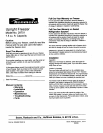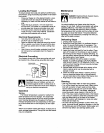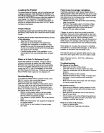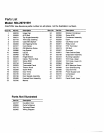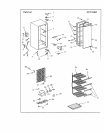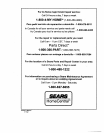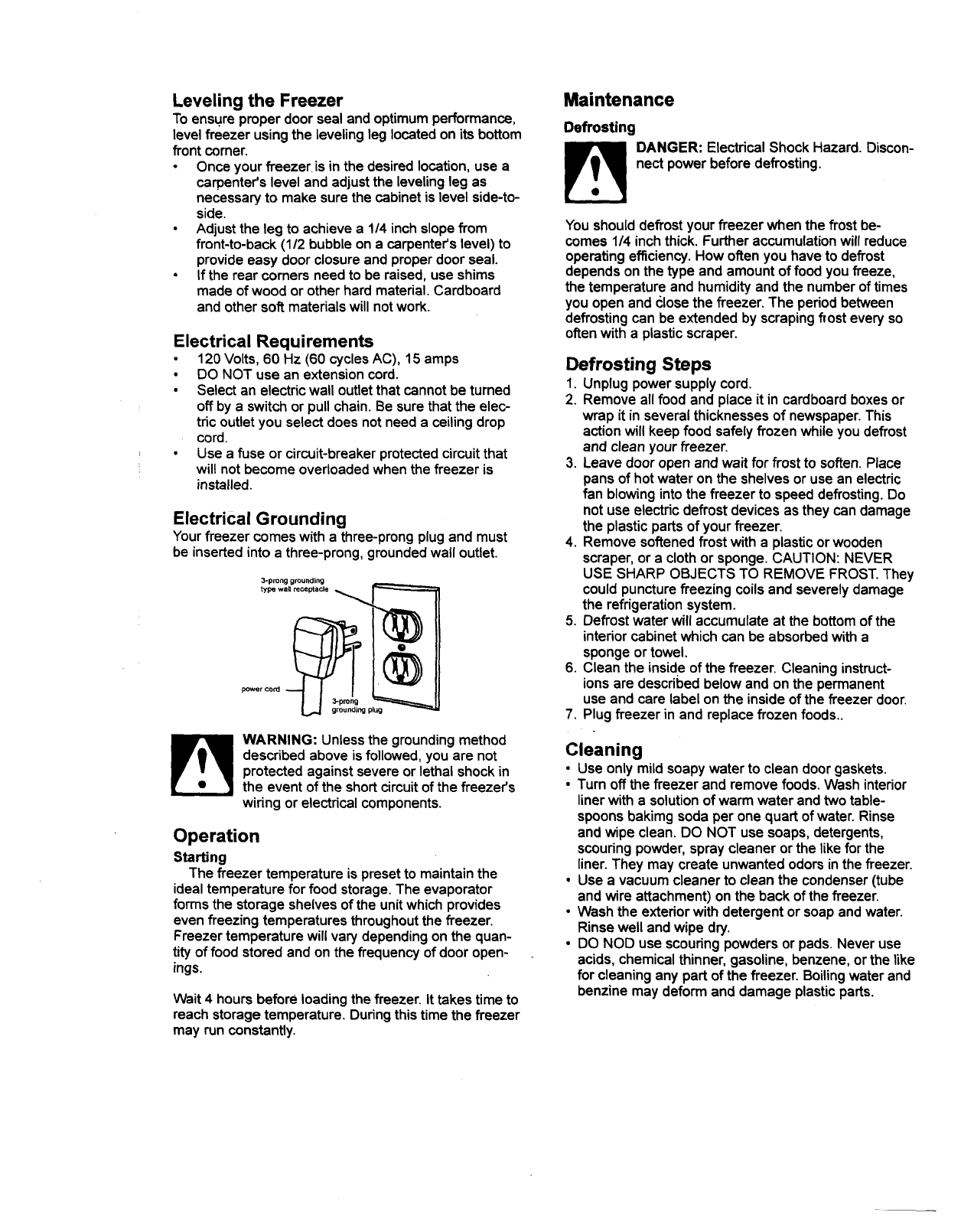
Leveling the Freezer
To ensure properdoor seal and optimumperformance,
levelfreezer usingthe levelingleg locatedon its bottom
frontcorner.
• Onceyourfreezer is inthe desiredlocation,usea
carpenter'slevel and adjustthe levelingleg as
necessaryto make surethe cabinetis level side-to-
side.
• Adjustthe leg to achievea 1/4 inchslopefrom
front-to-back(1/2 bubbleon a carpenter's level) to
provideeasy doorclosureand properdoor seal.
• Iftherear corners needto be raised,useshims
made of wood or other hard material.Cardboard
and other soft materialswill notwork.
Electrical Requirements
• 120 Volts,60 Hz (60 cyclesAC), 15 amps
• DO NOT use an extensioncord.
• Select an electricwall outletthat cannot be turned
off by a switchor pullchain.Be surethat the elec-
tricoutletyou select does notneed a ceilingdrop
cord.
• Use a fuse or circuit-breaker protected circuit that
will not become overloaded when the freezer is
installed.
Electrical Grounding
Yourfreezer comes with a three-prongplugand must
be insertedinto a three-prong,groundedwall outlet.
3-prong grounding
LJ
WARNING: Unless the groundingmethod
described above is followed,you are not
protectedagainst severe or lethal shockin
the event of the shortcircuitofthe freezer's
wiring or electricalcomponents.
Operation
Starting
The freezer temperature is preset to maintainthe
ideal temperatureforfood storage.The evaporator
formsthe storage shelvesof the unitwhich provides
even freezing temperaturesthroughoutthe freezer.
Freezer temperaturewill vary dependingonthe quan-
tity of food stored and on the frequencyof dooropen-
ings.
Wait 4 hours before loading the freezer, It takes time to
reach storage temperature. During this time the freezer
may run constantly.
Maintenance
Defrosting
_ DANGER: Electrical Shock Hazard. Discon-
nect power before defrosting.
You shoulddefrost your freezer when the frost be-
comes 1/4 inch thick. Furtheraccumulationwillreduce
operatingefficiency.How oftenyou have to defrost
dependson the type and amount of food youfreeze,
the temperatureand humidityandthe numberoftimes
youopen and closethe freezer. The periodbetween
defrostingcan be extended by scrapingfrostevery so
oftenwitha plasticscraper.
Defrosting Steps
1. Unplugpowersupplycord.
2. Remove allfood and place it in cardboardboxesor
wrap it inseveral thicknessesof newspaper.This
action willkeep food safely frozenwhile you defrost
and clean your freezer.
3. Leave door open and wait for frost to soften.Place
pansof hotwater on the shelvesor use an electric
fan blowingintothe freezer to speed defrosting.Do
notuse electricdefrostdevicesas they can damage
the plasticpartsof your freezer.
4. Removesoftened frost witha plasticorwooden
scraper,or a clothor sponge. CAUTION: NEVER
USE SHARP OBJECTS TO REMOVE FROST. They
couldpuncturefreezing coilsand severelydamage
the refrigerationsystem.
5. Defrostwater will accumulateat the bottomofthe
interiorcabinetwhich can be absorbedwitha
spongeortowel,
6. Clean the insideof the freezer. Cleaninginstruct-
ionsare describedbelow and on the permanent
use and care label on the insideof the freezer door.
7. Plug freezer in and replacefrozen foods..
Cleaning
• Use only mildsoapywater to clean doorgaskets.
• Turnoff the freezer and removefoods.Wash interior
linerwitha solutionof warm water and two table-
spoonsbakimg soda per one quart of water. Rinse
and wipe clean. DO NOT use soaps, detergents,
scouringpowder,spraycleaner orthe likefor the
liner.They may create unwanted odorsin the freezer.
• Use a vacuumcleaner to clean the condenser(tube
and wire attachment)on the back of the freezer.
• Wash the exteriorwithdetergent or soapand water.
Rinse well and wipe dry.
• DO NOD usescoudngpowdersor pads.Never use
acids, chemicalthinner,gasoline,benzene,or thelike
for cleaning any part of the freezer. Boilingwaterand
benzine may deform and damage plasticparts.



